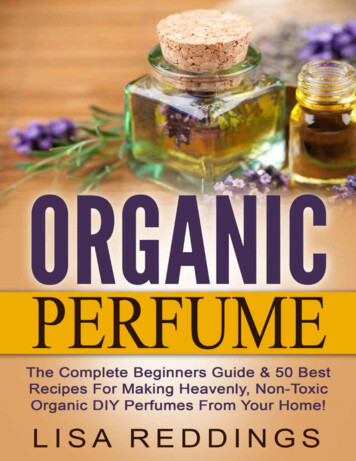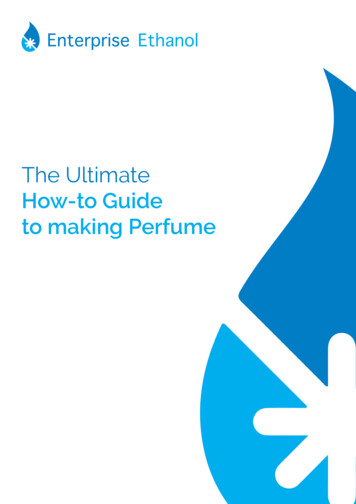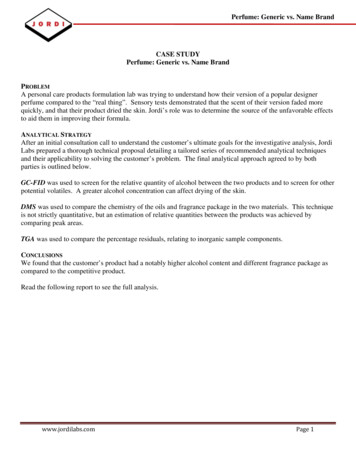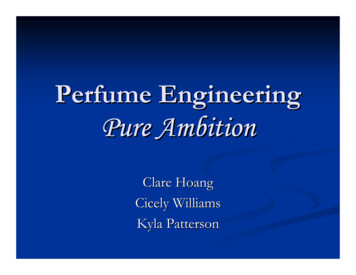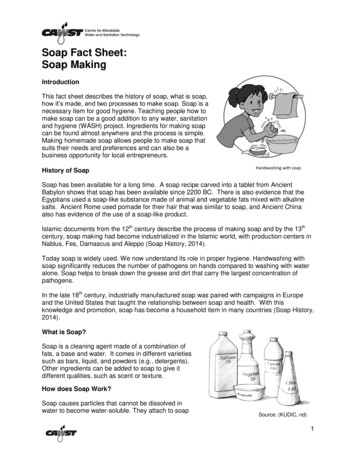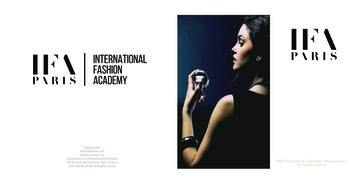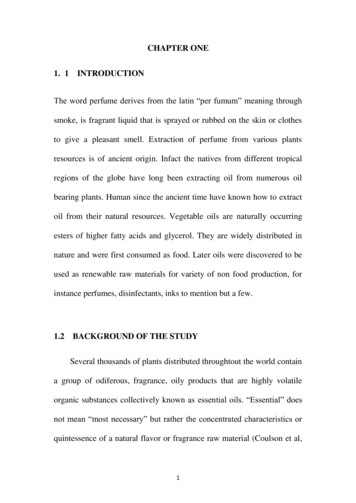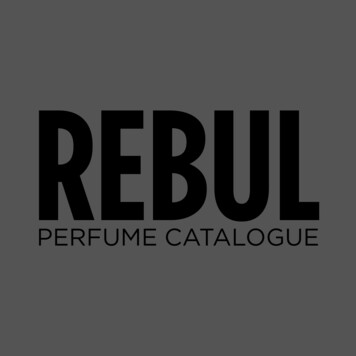
Transcription
Another eBookWholesaler PublicationPerfume, Soap and Candle MakingThe Beginner’s GuideBy Irene PalmerProudly brought to you byWOW Enterprises Inc.EmailRecommended Resources Web Site Hosting Service Internet Marketing Affiliate Program
“Perfume, Soap and Candle Making” by Irene PalmerPage 2 of 118Please Read This FirstTerms of UseThis Electronic book is Copyright 2007 John Williams. All rightsreserved. No part of this book may be reproduced, stored in aretrieval system, or transmitted by any means, electronic,mechanical, photocopying, recording, or otherwise, without writtenpermission from the copyright holder(s).You must not distribute any part of this ebook in any way at all.Members of eBookwholesaler are the sole distributors and mustabide by all the terms erThe advice contained in this material might not be suitable foreveryone. The author obtained the information from sourcesbelieved to be reliable and from his own personal experience, but heneither implies nor intends any guarantee of accuracy.These crafts involve ingredients and processes which require carefulobservance of all appropriate safety measures at all times byeveryone involved. You must accept full responsibility for youractions and assumptions.The author, publisher and distributors never give legal, accounting,medical or any other type of professional advice. The reader mustalways seek those services from competent professionals that canreview their own particular circumstances.The author, publisher and distributors particularly disclaim anyliability, loss, or risk taken by individuals who directly or indirectlyCopyright 2007 All Rights Reserved Worldwide
“Perfume, Soap and Candle Making” by Irene PalmerPage 3 of 118act on the information contained herein. All readers must accept fullresponsibility for their use of this material.All pictures used in this book are for illustrative purposes only. Thepictures must not be used for any other purpose.Some images in this book are 2008 Jupiterimages Corporation.The people in the pictures are not connected with the book, authoror publisher and no link or endorsement between any of them andthe topic or content is implied, nor should any be assumed.Copyright 2007 All Rights Reserved Worldwide
“Perfume, Soap and Candle Making” by Irene PalmerPage 4 of 118Table of ContentsPlease Read This First . 2Terms of Use . 2Disclaimer. 2Table of Contents . 4About the Author . 101. Perfume Making - An Overview . 112. The History of Perfume . 143. What is Needed to Make Homemade Perfumes?. 164. Making Your Own Perfume - The First Steps . 19The Things that You Need . 19Steps for Making your Perfume . 205. The Materials Needed and Where to Get Them . 216. Unit Conversions - Measuring and Mixing . 23Measuring Of Ingredients . 23Mixing Of Ingredients. 247. Bottling and Labeling. 258. Choosing a Formulation . 27Formulation Techniques for Perfume Making . 289. Aromas . 29Sources of Aromas. 2910. Solvent and Fixative. 31Solvent. 31Fixative . 31Copyright 2007 All Rights Reserved Worldwide
“Perfume, Soap and Candle Making” by Irene PalmerPage 5 of 11811. Creating Aromatherapy Perfumes at Home . 32Procedure for Making Aromatherapy Perfumes . 33Different Aromatherapy Recipes . 331. Calming Aromatherapy Perfume . 332. Energizing Aromatherapy Perfume . 343. Tranquilizing Aromatherapy Perfume . 344. Relaxing Aromatherapy Perfumes. 345. Blended Aromatherapy Perfume . 3512. Simple Recipes to Make Perfume at Home . 37Basic Perfume Recipe. 37Steps . 37Perfume using Essential Oils . 38Ingredients Necessary . 38Steps . 38Perfume using essential oils, water, and alcohol . 38Ingredients Necessary . 38Use Different Ingredients for Different Results . 39Part-II: Soap Making . 4114. Soap Making – An Introduction. 41The Cold Process Soap Making . 41Melt and Pour Soap Making. 41Rebatch Soap Making Method . 42Essential Precautions when Making Soap . 4315. How is Soap Made?. 4516. Methods of Making Soap . 47Soap Making Methods. 47Hot Process: . 48Melt and Pour . 48Rebatching . 48Copyright 2007 All Rights Reserved Worldwide
“Perfume, Soap and Candle Making” by Irene PalmerPage 6 of 11817. Getting Started - Making Soap from Scratch . 5018. Ingredients Needed to Make Soap . 52Other Requirements for Your Soap Making. 5319. Tools and Equipment to Make Cold Process Soap . 5420. Soap Making Safety Procedures . 5621. Soap Making Oils and Their Properties. 58Sweet Almond Oil . 58Aloe Vera Gel and Liquid . 58Apricot Kernel Oil . 58Avocado Oil. 58Beeswax . 58Calendula Oil. 58Canola Oil . 59Castor Oil. 59Cocoa Butter . 59Coconut Oil . 59Cottonseed Oil . 59Emu Oil . 59Evening Primrose Oil . 59Grapeseed Oil . 60Hazelnut Oil . 60Hempseed Oil. 60Honey. 60Jojoba . 60Kukui Nut Oil . 60Lard . 60Macadamia Oil . 61Mango Butter . 61Monoi Oil . 61Neem Oil . 61Olive Oil . 61Copyright 2007 All Rights Reserved Worldwide
“Perfume, Soap and Candle Making” by Irene PalmerPage 7 of 118Palm Oil/ Vegetable Tallow . 61Palm Kernel Oil . 61Peanut Oil . 62Safflower Oil. 62Sesame Seed Oil. 62Shea Butter. 62Sunflower Oil . 62Vegetable Shortening. 62Soybean Oil . 63Wheat Germ Oil. 6322. Using Natural Colorants in Soap Making . 64Three Tests for Natural Colorants . 64The Lye Test. 64The Oil Test . 64The Soap Batch Test . 6423. Rebatching Soap - The Hand Rebatch Method . 6624. Step-by-Step Instructions - Cold Process Soap Making. 6825. Make a Lye-Water Solution for Your Cold Process Soap . 7126. Step-by-Step Instructions - Melt and Pour Soap Making . 72Equipment and Materials Necessary. 72Procedure . 7227. Making Liquid Soap. 75Ingredients and Equipment for Making Liquid Soap . 75Basic tools for mixing lye and similar procedures . 75Procedure . 7528. Finding or Making Soap Making Molds . 78Design and Make Your own Soap Molds . 7829. Lavender-Mint Layered Soap Recipe. 80Copyright 2007 All Rights Reserved Worldwide
“Perfume, Soap and Candle Making” by Irene PalmerPage 8 of 118Ingredients . 80Procedure . 8030. Troubleshooting Your Soap Making Problems. 82Common Problems in Soap Making . 821. Curdling of soap mixture while stirring . 822. Grainy Mixture . 823. Tracing of soap does not occur or is very slow. 824. Mixture settles very quickly in pan. 825. Oil layer appears on the top when soap cools in the mold. 836. Soft and spongy Soap. 8331. Candle Making Basics. 84Types of Candles. 84Get Started Making Candles. 8532. Tools and Materials to Begin Candle Making. 87Essential Equipment . 8733. Candle Additives and How They Make Your Wax Work. 8934. Wax Melting Instructions . 91Safety Precautions . 9135. Candle Making Mold Techniques . 93Aluminum Molds. 93Wicking the Candle with a Pillar Pin or Rubber Plug . 93Polycarbonate Molds . 9436. Making Pillar Candles . 95A Simple Votive Candle. . 9537. Making a Simple Pillar Candle. 9838. Making Container-Based Candles. 102Equipment and ingredients . 102Copyright 2007 All Rights Reserved Worldwide
“Perfume, Soap and Candle Making” by Irene PalmerPage 9 of 118Clean-up Tips . 10339. Make a Halloween Appliqué Candle. 105Materials Required . 105Procedure . 10540. Candle Making Safety Tips . 108Candle Making Safety Tips . 108Supplies and Classes. 111U.S.A. and Canada. 112UK and Europe: . 115Australia . 116Author’s Afterword. 117Copyright 2007 All Rights Reserved Worldwide
“Perfume, Soap and Candle Making” by Irene PalmerPage 10 of 118About the AuthorIrene Palmer has learned many crafts and enjoys sharing the itemsshe produces with her friends and, especially, members of her largefamily.She also is happy to help other people to improve their craft skills.Many of her friends kept asking her to write down the steps for thevarious craft projects that she helped them with.After a couple of years, she decided to tidy up her files and usethem to fill another of her life-long ambitions – to write a book!Irene hopes that her experience and the information that she haspreviously only shared with the people around her will now helpspread the skills and joy of crafting wider.Copyright 2007 All Rights Reserved Worldwide
“Perfume, Soap and Candle Making” by Irene PalmerPage 11 of 118Part-I: Perfume Making1. Perfume Making - An OverviewPerfume is a combination of manyaromatic compounds and solventswith specific essential oils andfixatives. Overall, this combinationproduces a nice smell in yourenvironment and on your body.Keeping perfumes in a protected place, away from heat and light,can guarantee a longer shelf life.Perfume making is a complex process of mixing all necessaryingredients in specific proportions to get the desired effect. Plants,flowers, leaves, and bark are important natural sources of aromaticcompounds and different essential oils. Different parts of differentplants give different aromas. Orange tree, blossoms, and leavesoffer orange oils and petit grain.Barks of cinnamon and cascarilla have a special fragrance. Flowersare the major sources of varied types of aromas like jasmine, rose,tuberose, mimosa, and other citrus trees. Rinds of grapefruit,lemons, and oranges offer a special aroma. In some cases, leaveslike those of violets and rosemary have a special aroma of theirown. Some seeds like those of nutmeg, coriander, cardamom,cocoa, and anise also offer a special aroma.Animals are also important sources of special aromas like odoroussacs of the civets, musk sacs from Asian musk deer, honeycomb ofthe honeybee, and others. Presently most of the perfumes containCopyright 2007 All Rights Reserved Worldwide
“Perfume, Soap and Candle Making” by Irene PalmerPage 12 of 118synthetic aromatic compounds like those from petroleum distillates,coal tar, organic feedstock, or pine resins. Synthetic compounds arebeneficial and prove to be good alternate sources for compoundsthat are difficult to obtain from natural sources.Perfume making is a long process. Before starting, you shouldacquire all odorants through proper techniques. You may have touse strong solvents or heat to get these odorants. Sometimes, suchprocesses could change the odor or lessen aroma extensively. Someof these techniques include supercritical fluid extraction, solventextraction, dry or steam distillation, ethanol extraction, oreffleurage, which involves absorption of aromatic compounds intowax.Purity of essential oils or fragrant extracts depends on specifictechniques used to obtain such extracts. Soaking some specificcompounds in ethanol can help extract pure fragrance without anyprocess of dissolving. Concretes like thick oily liquids and waxysolids can help in extraction of hydrophobic compounds. Expressionoils are available from distillation and expression processes.Tinctures are thin fluids. You can produce fragrant materials bysoaking raw materials directly in ethanol.A perfumer is an expert in the making or composing of perfumes.Rather, a perfumer has a keen sense and knowledge of smell,fragrance, and other aesthetics. This person has intensive trainingin various abstract concepts and moods of perfume making. He candistinguish between different scents and smells. He therefore,designs and produces perfumes according to client specifications.Clients could be huge perfume companies, fashion houses, andothers.Copyright 2007 All Rights Reserved Worldwide
“Perfume, Soap and Candle Making” by Irene PalmerPage 13 of 118The perfumer blends perfumes according to desired fragrance andconcentration. In some cases, clients require perfumes to arousespecific feelings. So, the perfumer uses different combinations ofaromatic compounds with essential oils to deliver the desiredfragrance of perfume. This process could take many months andsometimes even years to deliver the perfect desired fragrance.Sometimes clients use these fragrances to add to shampoos,detergents, and others.There is no single and perfect technique for perfume making. It alldepends on your choice of fragrance and other specifications like ifit should be a lingering fragrance or a short and sweet smell alone.Careful organization of all different processes is essential to arrive atthe correct and suitable scent. The process starts with aptorganization of different ingredients like primary scents, modifiers,blenders, and fixatives.Different primary scents can constitute a single fragrance. Blendingof fragrance oils with water and ethyl alcohol requires their properstorage and filtration within a specified minimum period. Someperfumers and companies use available fragrance bases to blendwith essential oils and deliver new concepts or new scents. Thisprocess offers extensive variation and experimentation withdifferent essences and fragrances.Use of perfumes could raise some health issues like allergies, skinirritations, serious ailments, and physiological changes. FDAregulations only govern the ingredients in use in making perfumes.There is no FDA regulation for the perfume industry. Further, manycompanies do not list ingredients in use to preserve their tradesecrets.Copyright 2007 All Rights Reserved Worldwide
“Perfume, Soap and Candle Making” by Irene PalmerPage 14 of 1182. The History of PerfumeThe word perfume owes its meaning to Latin word ‘per fumum’.This means through smoke. The art of making perfumes had itsorigin in ancient Mesopotamia and Egypt. Tapputi is the world’s firstrecorded chemist and perfume maker from Mesopotamia. Later,perfumes spread to Rome and Arabian countries. Most of theperfumes from these places were based on incense.Egyptians used perfumes in religious rituals like cleansingceremonies. Perfumed oils had many medicinal properties and werein use in balms and ointments. Slowly, Egyptian women startedusing perfumed creams and oils as toiletries. This also led to thespread of perfumes to other countries like Greece, Arabiancountries, and Rome. However, with the fall of the Roman Empire,perfumes started losing their importance in this part of the world.However, Islamic countries kept their traditions alive and developedtheir perfume making.From the twelfth century onwards, perfumes started regaining theirimportance across different pockets of the world. France was theforemost in use and development of perfumes. The court of LouisXV was popular as ‘the perfumed court’ due to application ofperfumes to furniture, clothing, and everything else.Eau de Cologne was an invention of the eighteenth century. Itoffered a refreshing blend of various scents like neroli, rosemary,bergamot, and lemon. Liquid perfumes now became popular andwere available in glass bottles. Perfumes underwent major changesin the nineteenth century. This was due to improved perfumeCopyright 2007 All Rights Reserved Worldwide
“Perfume, Soap and Candle Making” by Irene PalmerPage 15 of 118making techniques, use of different chemicals, and changes intastes of perfume users.Grasse in Provence was then the largest production center ofperfumes. Slowly, Paris became the commercial center forproduction of perfumes. This also led to development of differentperfume houses across Europe. William Sparks Thomson set up TheCrown Perfumery in 1872 with a collection of floral fragrances.Leather fragrances became popular in the 1930s. Noteworthyperfumers include Jacques Fath, Christian Dior, Pierre Balmain, JeanPatou, and Nina Ricci. Presently, there are more than 30,000designer perfumes in the market catering to all ranges of cost andluxury in addition to their fragrance.Copyright 2007 All Rights Reserved Worldwide
“Perfume, Soap and Candle Making” by Irene PalmerPage 16 of 1183. What is Needed to Make Homemade Perfumes?Perfumes are a perennial favorite and many people love to wear aperfume. It makes you smell nice and the scent lingers for a longtime. Perfumes are an ideal combination of fragrant oils, fixatives,aroma blends, and solvents.The main composition of perfume consists of base perfume oils,which could be animal or synthetic. Mixing of solvents helps dilutetheir concentration and make it easy to use and apply. Undilutedand pure form of base oils cause allergies and skin damage.You can make perfumes at home. Your choice of perfumes decidesthe ingredients you need to make perfumes at home. Some of themare strong and last long while some have a soft smell and do notlinger long.There are three main categories of ingredients necessary for makingperfumes.They are: Pure grain oil Essential oils, available from different plant and animalsources, form the essence of your perfume, and WaterEssential oils as in use in making perfumes belong to three differentcategories. You normally mix equal quantities of each of these oilsin your perfume.These categories include:Copyright 2007 All Rights Reserved Worldwide
“Perfume, Soap and Candle Making” by Irene Palmer Page 17 of 118Base oil or Basenotes: These oils havethe strongest scentamong different oils inuse in your perfume.Hence, their scentlingers longest. Popular base notes include Vanilla,Sandalwood, Cinnamon, Lichens, Mosses, and Ferns. Middle oil or Middle notes: Theseoils have a mild scent and influencethe overall product after mixing ofall oils in the perfume. Popularmiddle notes include Geranium,Lemongrass, Ylang-Ylang, andNeroli. Top oil or Top notes: You addthese oils to your perfume mixtureafter adding middle notes. Theseoils help all oils to form a newscent and add essence to yourperfume. Top notes include Rose,Orchid, Bergamot, Lemon,Lavender, and Lime.Perfumes require proper storage as otherwise they deteriorate fastand lose their smell. After making your perfumes, put them intotightly sealed containers and store in a fridge with temperaturesbetween three and seven degrees Celsius. Perfumes should be keptaway from light and heat sources, oxygen, and other organiccompounds.Copyright 2007 All Rights Reserved Worldwide
“Perfume, Soap and Candle Making” by Irene PalmerCopyright 2007 All Rights Reserved WorldwidePage 18 of 118
“Perfume, Soap and Candle Making” by Irene PalmerPage 19 of 1184. Making Your Own Perfume - The First StepsYou can make your own perfume at home. Perfume making is not ahuge task; it only involves collecting essential ingredients, mixingthem appropriately, and later bottling them perfectly to preservethe scent.Perfume making involves mixing of three main constituents. Theseare essential oils, water, and pure grain alcohol, although notnecessarily in that order. Normally, you mix all ingredients in equalquantities. Yet, you can try different recipes to make a differentcombination and develop a new perfume and a different scent.Essential oils could be plant or animal extracts like lavender oil,bergamot oil.The I
“Perfume, Soap and Candle Making” by Irene Palmer Page 13 of 118 The perfumer blends perfumes according to desired fragrance and concentration. In some cases, clients require perfumes to arouse specific feelings. So, the perfumer uses different combinations of aromatic compounds with essential oils to deliver the desired fragrance of perfume.File Size: 1MB
